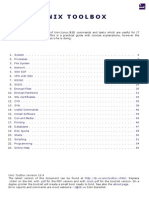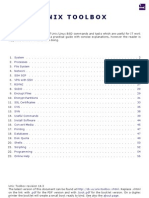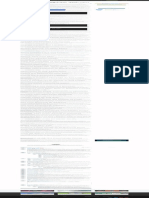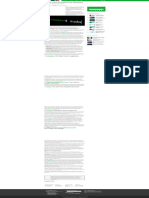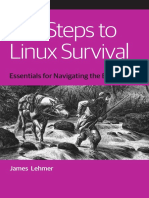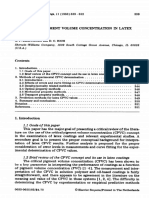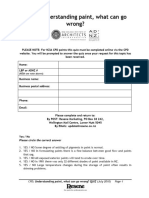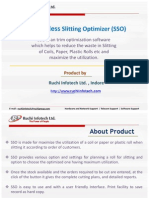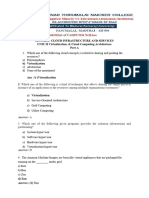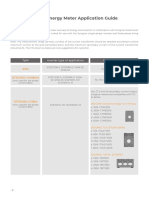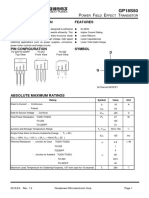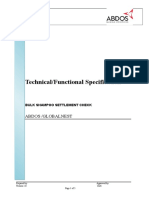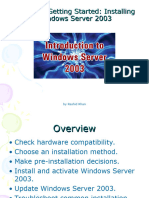A Linux Command Line Primer - DigitalOcean
Uploaded by
b3ry 17A Linux Command Line Primer - DigitalOcean
Uploaded by
b3ry 17General Availability for Internal Load Balancer is here for all customers Blog Docs Get Support Contact
Blog Docs Get Support Contact Sales
Products Solutions Developers Partners Pricing Log in Sign up
Tutorials Questions Product Docs Cloud Chats Search Community
Tutorial Series: Getting Started With Cloud Computing
CONTENTS
Try DigitalOcean
for free
Understanding p with Ubuntu 4/39 A Linux Command Line Primer 5/39 SSH Essentials: Worki
the Terminal Click below to sign
Window up and get $200 of
credit to try our
Becoming products over 60
Familiar with days!
Directories // TUTORIAL //
Sign up
Listing Contents
and A Linux Command Line Primer
Understanding Updated on June 17, 2021
Permissions Popular Topics
Cloud Computing Linux Basics Spin Up Linux Commands
Navigating the AI/ML
Filesystem Ubuntu
Creating and Lisa Tagliaferri Linux Basics
Modifying Text
Files JavaScript
Python
Autocompletion
i MySQL
Docker
Kubernetes
All tutorials
Talk to an expert
Introduction
Note: The interactive terminal in this tutorial is currently disabled as we work on improving our
interactive learning experiences. You can still use this tutorial to learn about the command line and
practice Linux commands, but you will need to use the terminal on your computer or a virtual machine.
Today, many of us are familiar with computers (desktops and laptops), smartphones, and tablets which
have graphical user interfaces (also referred to as GUIs), allowing us to navigate apps, the web, and
our files (like documents and photos) through a visual experience. The Windows, macOS, and Linux
operating systems each present varieties of a desktop environment (with images of folders and files,
for example), and dropdown menus, all of which provide access to computer programs, applications,
and our own media.
Although GUIs can be an intuitive way to use a computer for many users, they often do not provide us
with the greatest power over our machines, and they may prevent us from having full administrative
access on our computers, including installing, modifying, or deleting software or files. Additionally, as
GUIs are largely visual, they are often not as accessible as they could be for all users.
One way of navigating both your own personal computer and remote cloud servers without a GUI is
through a text-based terminal or command-line interface CLI .
Terminal interfaces exist on almost every computer operating system, and terminal emulators are also
available as apps for tablets and smartphones. Terminals provide users with greater overall access to
their machines through increased administrator access, greater ability to customize environments, and
opportunities to automate processes. They also provide users with the ability to access remote
computers, such as cloud servers.
This tutorial will provide users who are new to terminal environments with the basics of using a
command-line interface through an embedded web terminal in your browser, which you can launch
below. If you already have some familiarity with terminals, you may prefer to go through our
Introduction to the Linux Terminal tutorial instead. Once you complete this tutorial, you should have an
understanding of how to use a terminal on a Linux (or macOS) computer or server.
Understanding the Terminal Window
When you first get access to a new computer or smartphone, you likely want to turn it on and get a feel
for how to use it by checking which apps are available, and to learn where things are so that you can
customize the device to suit your needs. You can become familiar with a computer through a terminal
in a similar way.
The interactive terminal you launched in this browser window, by clicking the Launch an Interactive
Terminal! button above, displays a white rectangle on the bottom of your browser window:
If you have not launched the terminal, please do so now using the button at the beginning of this
tutorial.
In your interactive browser terminal, there should be a dollar sign, $ and a blinking cursor. This is
where you will begin to type commands to tell the terminal what to do.
The terminal you have launched is an Ubuntu 20.04 terminal. Ubuntu is a popular distribution of Linux,
which was originally based on the Unix operating system. The macOS operating system is also based
on Unix. If you are reading this tutorial on a Linux or macOS machine, you should have a terminal on
your operating system that works similarly to the embedded terminal weʼll be using in this guide.
In many of these Unix (or *nix-based) operating systems, the symbols at the end of the prompt may be
a $ symbol or a # symbol, which mean the following:
$ or dollar sign — you are logged in as a regular user
# or hashtag/pound symbol — you are logged in as a user with elevated privileges
The user that is noted in the # environment is also known as a root user, which is considered to be a
super user, or administrator, by default.
For our purposes within the browser terminal below, you are logged in as a regular user, but you also
have administrator privileges via the sudo command. As this is a temporary terminal, you do not need
to worry about what you type into the terminal, as we will destroy everything once we are done.
Similarly, with a cloud server, it is possible to destroy a server and start fresh if something goes awry.
Please note that it is best to exercise more care when working on a local computerʼs terminal as there
may be changes you can make as an administrator on the terminal that can make permanent changes
on the computer you are using.
At this point, with your terminal launched in the browser, you can begin to type into it using your local
computer. Your text will appear at the blinking cursor. Weʼll learn about what we can type here in the
next sections.
Becoming Familiar with Directories
Weʼll begin working with the terminal by typing a command. A command is an instruction that is given
by a user, communicating what it is that the user wants the computer to do. You will be typing your
commands into the terminal and then pressing ENTER or RETURN when you are ready for the computer
to execute on a given command.
Letʼs type the following command followed by ENTER . You can also copy the command, or ask it to run
in a launched interactive terminal by clicking on the relevant links in the code block below when you
hover over it with a mouse.
Copy
$ pwd
Once you run this command, youʼll receive the following output:
Output
/home/sammy
The pwd command stands for “present working directory,” and it lets you know where you are within
the current filesystem.
In this example, you are in the directory (or folder) called /home/sammy , which stands for the user called
sammy . If you are logged in as root , a user with elevated privileges, then the directory would be called
/root . On a personal computer, this directory may be called the name of the user who owns the
computer. Sammy Sharkʼs computer may have /sammy or /sammy-shark or /home/sammy as their primary
user directory.
Right now, this directory is empty. Letʼs create a directory to store the files weʼll be creating as we go
through this tutorial, which we can call files , for example.
To do this, weʼll use the mkdir command, which stands for “make directory.” After we type the
command, weʼll need to write the name of the folder, which will pass the value to the command so that
the command can execute on creating this directory. This value (the name of the folder) is known as
an argument, which is an input being given to the command. If you are familiar with natural language
grammar, you can think of the argument as an object that is being acted upon by the verb of the
command.
In order to create a new directory called files weʼll write the following, with mkdir being the command
and files being the argument:
Copy
$ mkdir files
After you run this command, you wonʼt receive any output other than a new line with a blinking cursor.
With this fresh line on your terminal, you are ready for your next command.
Listing Contents and Understanding Permissions
As we have not received any concrete feedback about our new directory yet, weʼll use a command to
learn more about what is in our present working directory. You can confirm that the new directory is
indeed there by listing out the files in the directory, with the ls command (signifying “list”):
Copy
$ ls
Youʼll receive output that confirms the files directory is there:
Output
files
This gives us general information about what is in our present working directory. If we want to have
more details, we can run the ls command with what is called a flag. In Linux commands, a flag is
written with a hyphen - and letters, passing additional options (and more arguments) to the command.
In our example, weʼll add the -l flag, which — when paired with ls — denotes that we would like to
use the option to use a long listing format with our command.
Letʼs type this command and flag, like so:
Copy
$ ls -l
Upon pressing ENTER , weʼll receive the following output in our terminal:
Output
total 4
drwxr-xr-x 2 sammy sammy 4096 Nov 13 18:06 files
Here, there are two lines of output. The first line refers to computer memory blocks being allocated to
this directory, the second line mostly refers to user permissions on the file.
To get a somewhat more human readable output, we can also pass the -h or --human-readable flag,
which will print memory sizes in a human readable format, as below. Generally, one hyphen - refers to
single-letter options, and two hyphens -- refer to options that are written out in words. Note that some
options can use both formats. We can build multiple options into a command by chaining flags
together, as in -lh .
For example, the two commands below deliver the same results even though they are written
differently:
Copy
$ ls -lh
Copy
$ ls -l --human-readable
Both of these commands will return the following output, similar to the output above but with greater
context of the memory blocks:
Output
total 4.0K
drwxr-xr-x 2 sammy sammy 4.0K Nov 13 18:06 files
The first line of output lets us know that 4K of computer memory is dedicated to the folder. The
second line of output has many more details, which weʼll go over in more detail. A general high-level
reference of all the information that weʼll cover is indicated in the table below.
File type Permissions Link count Owner Group File size Last modified date File name
d rwxr-xr-x 2 sammy sammy 4.0K Nov 13 18 06 files
Youʼll note that the name of our directory, files , is at the end of the second line of output. This name
indicates which specific item in the /home/sammy user directory is being described by the line of output.
If we had another file in the directory, we would have another line of output with details on that file.
At the front of the line, there is a list of characters and dashes. Letʼs break down the meaning of each
of the characters:
Character Description
directory (or folder) — a type of file that can hold other files, useful for organizing a file
d
system; if this were - instead, this would refer to a non-directory file
r read — permission to open and read a file, or list the contents of a directory
write — permission to modify the content of a file; and to add, remove, rename files in a
w
directory
execute — permission to run a file that is a program, or to enter and access files within a
x
directory
In the first drwx characters of the string, the first letter d means that the item files is a directory. If
this were a file other than a directory, this string of characters would begin with a hyphen instead, as in
-rwx , where the first hyphen signifies a non-directory file. The following three letters, rwx , represent
the permissions for the owner of the directory files , and mean that the directory files can be read,
written, and executed by the owner of the file. If any of these characters were replaced with hyphens,
that would mean that the owner does not have the type of permission represented by that character.
Weʼll discuss how to identify the owner of a file in just a moment.
The next three characters in the output are r-x , which represent the group permissions for the files
directory. In this instance, the group has read and execute permissions, but not write permissions, as
the w is replaced with a - . Weʼll discuss how to identify the group in just a moment.
The final three characters of the first string, r-x represents the permissions for any other groups that
have access to the machine. In this case, these user groups can also read and execute, but not write.
The number 2 in the output refers to the number of links to this file. In Linux, links provide a method to
create shortcuts to help users navigate the filesystem. When you created this file, Linux did some
background work to create an absolute link to the file, and a self-referential link to the file to allow for
users to navigate along a relative path. Weʼll discuss absolute and relative paths in the next section.
After the number 2 , the word sammy is displayed twice. This part of the output gives information about
the owner and group associated with the files directory. The first instance of sammy in this line refers
to the owner of the directory, whose permissions we saw earlier are rwx . The sammy user is the owner
as we created the files directory as the sammy user and are the current owner of the file. Though the
sammy user is the only user in our current environment, Unix-like operating systems often have more
than one user and so it is useful to know which user has ownership of a file.
The second instance of sammy refers to the group that has access to the files directory, whose
permissions we saw earlier are r-x . In this case, the group name is the same as the owner username
sammy . In real-world environments, there may be other groups on the operating system that have
access to the directory, such as staff or a username like admin .
The rest of the details on this output line are the 4.0K for the memory allocation of the directory on the
machine, and the date that the directory was last modified (so far, we have just created it).
With this greater understanding of file systems and permissions, we can move onto navigating the file
system on our Linux terminal.
Navigating the Filesystem
So far, we have learned how to determine where we are in a filesystem, how to make a new directory,
how to list out files, and how to determine permissions.
Letʼs next learn how to move around the file system. We have made a new directory, but we are still in
the main /home/sammy user directory. In order to move into the /home/sammy/files directory that we have
created, weʼll use the cd command and pass the name of the directory we want to move into as the
argument. The command cd stands for “change directory,” and weʼll construct it like so:
Copy
$ cd files
Again, you wonʼt receive output other than a new line with a blinking cursor, but we can check that we
are in the /home/sammy/files directory with the pwd command we used earlier:
Copy
$ pwd
Youʼll get the following output, confirming where you are:
Output
/home/sammy/files
This validates that you are in the /home/sammy/files directory of the /home/sammy user directory. Does
this syntax look familiar to you? It may remind you of a websiteʼs URL with its forward slashes, and,
indeed, websites are structured on servers within directories, too.
Letʼs move to the primary directory of the server. Regardless of where we are in a filesystem, we can
always use the command cd / to move to the primary directory:
Copy
$ cd /
To confirm that we have moved and learn what is in this directory, letʼs run our list command:
Copy
$ ls
Weʼll receive the following output:
Output
bin boot dev etc home lib lib32 lib64 libx32 media mnt opt proc root run s sbin sr
There are a lot of files in there! The / directory is the main directory of a Linux server, referred to as
the “root” directory. Note that the root directory is different from the default “root” user. You can think
of the / directory as the major artery of a Linux machine, as it contains all the folders necessary to run
the computer. For example, the sys directory holds the Linux kernel and system information virtual
filesystem. If you would like to learn more about each of these directories, you can visit the Linux
Foundation documentation.
Youʼll also notice that there is a directory we have been in already, the /home user folder. From the /
directory, we can change directories back into /home then back into files , or we can move directly
back into that folder by typing the absolute path there with cd :
Copy
$ cd /home/sammy/files
Now, if you run pwd youʼll receive /home/sammy/files as your output.
A file path is the representation of where a file or directory is located on your computer or server. You
can call a path to a file or directory in either a relative or absolute way. A relative path would be when
we move to a location relative to our current working directory, like we did when we were already in
/home/sammy/ and then moved into files/ . An absolute path is when we call the direct line to a
location, as we did above with /home/sammy/files , showing that we started in the / directory, called the
/home/sammy/ user directory and then the nested files/ directory.
Additionally, Linux leverages dot notation to help users navigate via relative paths. A single . stands
for the directory you are currently in, and a double .. stands for the parent directory. So, from where
we currently are ( /home/sammy/files ), we can use two dots to return to the parent /home/sammy user
directory, like so:
Copy
$ cd ..
If you run pwd , youʼll receive /home/sammy as your output, and if you run ls , youʼll receive files as
your output.
Another important symbol to be familiar with is ~ which stands for the home directory of your
machine. Here, our home directory is called /home/sammy for the sammy user, but on a local machine it
may be your own name as in sammy-shark/ .
You can type the following from anywhere on your machine and return to this home directory:
Copy
$ cd ~
At this point, feel free to navigate around your file system with the commands you have learned so far.
In the next section, weʼll begin working with text files.
Creating and Modifying Text Files
Now that we have a foundation in the Linux file system and how to get around it, letʼs start creating
new files and learn about how to manipulate text on the command line.
Letʼs first be sure that weʼre in the files/ directory of the /home/sammy user folder, which we can do by
either verifying with pwd , or by changing directories on the absolute path:
Copy
$ cd /home/sammy/files
Now, weʼll create a new text file. Weʼll be making a .txt file, which is a standard file that can be read
across operating systems. Unlike .doc files, a .txt file is composed of unformatted text. Unformatted
text, including the text in .txt files, can readily be used on the command line, and therefore can be
used when working with textual data programmatically (as in, to automate text analysis, to pull
information from text, and more).
Weʼll begin by using the touch command, which can create a new file or modify an existing file. To use
it, you can use the command touch and pass the name of the text file you want to create as the
argument, as demonstrated below.
Copy
$ touch ocean.txt
Once you press ENTER , youʼll receive a new line of the command prompt, and you can list the current
contents of files/ to ensure it was created.
Copy
$ ls
Output
ocean.txt
So far we have created an ocean.txt file which contains no text at the time of creation.
If we want to create a text file that is initialized with text, we can use the echo command, which is used
to display strings of text in Linux.
We can use echo directly on the command line to have the interface repeat after us. The traditional
first program, "Hello, World!" , can be written with echo like so:
Copy
$ echo Hello, World!
Output
Hello, World!
Named for Echo of Ovidʼs Metamorphosis, the echo command returns back what we request. In this
case, it echoed, “Hello, World!” On its own, however, the echo command does not allow us to store the
value of our text into a text file. In order to do that, we will need to type the following:
Copy
$ echo "Sammy the Shark" > sammy.txt
The above command uses echo , then the text we would like to add to our file in quotes, then the
redirection operator > , and finally the name of our new text file, sammy.txt .
We can check that our new file exists, again with ls .
Copy
$ ls
Output
ocean.txt sammy.txt
We now have two text files in our /home/sammy/files user folder. Next, we can confirm that the file
sammy.txt does have the text we asked the terminal to echo into it. We can do that with the cat
command. Short for concatenate, the cat command is very useful for working with files. Among its
functions is showing the contents of a file.
Copy
$ cat sammy.txt
Once we run the command, weʼll receive the following output:
Output
Sammy the Shark
If we were to run cat on the empty file ocean.txt , we would receive nothing in return as there is no
text in that file. We can add text to this existing file with echo as well. Letʼs add a quote from Zora
Neale Hurston to the file.
Copy
$ echo "Some people could look at a mud puddle and see an ocean with ships." > ocean.txt
Now, if we run cat on the file, weʼll receive output of the text we just entered.
Copy
$ cat ocean.txt
Output
Some people could look at a mud puddle and see an ocean with ships.
So far, we have created text files and have added text to these files, but we have not yet modified
these files. If we would like to do that, we can use a command-line text editor. Several popular choices
exist, including Vim and Emacs. For our purposes, weʼll use nano, which is a less complex CLI text
editor program that we can use to begin our exploration.
The nano text editor can be summoned with the nano command. If we want to edit our existing
sammy.txt file, we can do so by passing the file name as an argument.
Copy
$ nano sammy.txt
The file will open up on your terminal:
sammy.txt
Sammy the Shark
With your keyboardʼs arrow keys, move your cursor to the end of the line and begin typing a few lines
from the perspective of Sammy.
Note: On the command line, you canʼt use your mouse or other pointer to navigate, both through the file
system and within files. Youʼll need to use your keyboard, and your arrow keys in particular, to move
around textual files.
When youʼre done with your file, it may read something like this:
sammy.txt
Sammy the Shark
Hello, I am Sammy.
I am studying computer science.
Nice to meet you!
With your file now containing the text you would like, we can now save and close the file. You may
notice that there is some guidance at the bottom of your terminal window:
^G Get Help ^O WriteOut ^R Read File ^Y Prev Page ^K Cut Text ^C Cur Pos
^X Exit ^J Justify ^W Where Is ^V Next Page ^U UnCut Text ^T To Spell
Because we are currently done with working on this file, we would like to Exit the file. Here, the ^
symbol refers to the Control or CTRL key on your keyboard, and the output above tells us that we need
to combine that key with X (use this lower case, without pressing the SHIFT key) in order to leave the
file. Letʼs press those two keys together:
CTRL x
The above is often written inline as CTRL + X or Ctrl+x in technical documentation.
At this point, youʼll receive the following prompt:
Output
Save modified buffer?
Y Yes
N No ^C Cancel
In order to save it, weʼll press the letter y for yes:
Youʼll receive feedback like the following.
Output
File Name to Write: sammy.txt
There are additional options, including cancelling with CTRL + C , but if you are comfortable with closing
the file, you can press ENTER at this point to save the file and exit it.
Letʼs say that we want to make a few files of students at DigitalOcean University. Letʼs create a new
directory in files/ called students :
Copy
$ mkdir students
Next, letʼs move sammy.txt into the new students/ directory. The mv command, which stands for move,
will allow us to change the location of a file. The command is constructed by taking the file we want to
move as the first argument, and the new location as the second argument. Both of the following
executions will produce the same result.
Copy
$ mv sammy.txt students
Copy
$ mv sammy.txt students/sammy.txt
This latter option would be useful if we would like to change the name of the file, as in mv sammy.txt
students/sammy-the-shark.txt .
Now, if we run the ls command, weʼll see that only ocean.txt and the students/ directory are in our
current directory ( files/ ). Letʼs move into the students/ folder.
Copy
$ cd students
In order to have a template for the other students, we can copy the sammy.txt file to create more files.
To do this, we can use the cp command, which stands for copy. This command works similarly to the
mv command, taking the original file as the first argument, and the new file as the second argument.
Weʼll make a file for Alex the Leafy Seadragon:
Copy
$ cp sammy.txt alex.txt
Now, we can open alex.txt and inspect it.
Copy
$ nano alex.txt
So far, alex.txt looks identical to sammy.txt . By replacing some of the words, we can modify this file
to read like the following. Note that you can use CTRL + K to remove an entire line.
alex.txt
Alex the Leafy Seadragon
Hello, I am Alex.
I am studying oceanography.
Nice to meet you!
You can save and close the file by pressing CTRL + X then y then ENTER .
If you would like to get more practice with text files, consider creating files for Jamie the Mantis
Shrimp, Jesse the Octopus, Drew the Squid, or Taylor the Yellowfin Tuna.
Once you feel comfortable with creating, editing, copying, and moving text files, we can move onto the
next section.
Autocompletion and History
Many versions of the command line, including the interactive terminal embedded in this tutorial, allow
you to autocomplete and to reuse commands as you go. This supports you moving more quickly as it
saves you typing time.
Try typing cat along with the first few letters of one of the text files you have been working on — for
example, cat sa . Before you finish typing the whole file name of sammy.txt , press the TAB key instead.
This should autocomplete the full file name, so that your terminal prompt displays the following:
Copy
$ cat sammy.txt
Now, if you press ENTER , the terminal should return the contents of the file to the command line.
Another shortcut is to press the UP arrow key, which will let you cycle through the most recent
commands you have run. On a new line with a blinking cursor, press the UP arrow key a few times to
have quick access to your previous commands.
If you need to replicate all the commands you have done in your terminal, you can also summon the
entire history of this session with the aptly named history command:
Copy
$ history
Depending on how much you have practiced, you should receive 30 or more lines of commands,
starting with the following output:
Output
1 pwd
2 mkdir files
3 ls
4 ls -l
...
Familiarizing yourself with these shortcuts will support you as you become more proficient with the
command line interface.
Working with Files from the Web
One of the most exciting aspects of working on a command line interface connected to the internet is
that you have access to all of the resources on the web, and can act on them in an automated way.
With the terminal, you can also directly access cloud servers that you have credentials for, manage
and orchestrate cloud infrastructure, build your own web apps, and more. For now, as we have already
learned how to work with text files on the terminal, weʼll go over how to pull down a text file from the
web so that the machine we are using has that text file available to us.
Letʼs move back into the files/ directory:
Copy
$ cd /home/sammy/files
From here, weʼll use the curl command to transfer data from the web to our personal interactive
terminal on the browser. The command curl stands for client URL (web address).
We have uploaded a short passage from Jules Verneʼs Twenty Thousand Leagues Under the Seas on a
cloud server. Weʼll pass the URL of that file to the curl command, as demonstrated below.
Copy
$ curl https://assets.digitalocean.com/articles/command-line-intro/verne_twenty-thousand-leagues.txt
Once we press ENTER , weʼll receive the text of the passage as output to our terminal (excerpted below)
Output
"You like the sea, Captain?"
"Yes; I love it! The sea is everything. It covers seven tenths of the terrestrial globe.
...
"Captain Nemo," said I to my host, who had just thrown himself on one of the divans, "this
is a library which would do honor to more than one of the continental palaces, and I am
absolutely astounded when I consider that it can follow you to the bottom of the seas."
While itʼs interesting to have the text display on our terminal window, we do not have the file available
to us, we have only transferred the data but have not stored it. You can verify that the file is not there
by running ls ).
In order to save the text to a file, weʼll need to run curl with the -O flag, which enables us to output the
text to a file, taking the same name of the remote file for our local copy.
Copy
$ curl -O https://assets.digitalocean.com/articles/command-line-intro/verne_twenty-thousand-league
Youʼll receive feedback from the terminal that your file has downloaded.
Output
% Total % Received % Xferd Average Speed Time Time Time Current
Dload Upload Total Spent Left Speed
100 2671 100 2671 0 0 68487 0 --:--:-- --:--:-- --:--:-- 68487
If you would like to use a specific and alternate name of the file, you could do so with the -o flag and
pass the name of the new file as an argument (in this case, jules.txt ).
Copy
$ curl -o jules.txt https://assets.digitalocean.com/articles/command-line-intro/verne_twenty-thous
We can now work on this file exactly as we would any other text file. Try using cat , or editing it with
nano .
In the next section, weʼll clean up some of the files and exit our terminal.
Removing Files and Terminating Commands
As with any other computer, we sometimes need to remove files and folders that are no longer
relevant, and exit the program we are using.
Letʼs say that the students we know from DigitalOcean University have graduated and we need to
clean up their files and the relevant folder. Ensure you are in the students/ directory:
Copy
$ cd /home/sammy/files/students
If you run ls , your folder may have a few files, like so:
Output
alex.txt drew.txt jamie.txt jesse.txt sammy.txt taylor.txt
We can remove individual files with the rm command, which stands for remove. Weʼll need to pass the
file we want to remove as the argument.
Warning: Note that once you remove a file, it cannot be undone. Be sure that you want to remove the file
before pressing ENTER .
Copy
$ rm sammy.txt
Now, if we run ls , weʼll notice that sammy.txt is no longer in the folder:
Output
alex.txt drew.txt jamie.txt jesse.txt taylor.txt
While we now know we can remove individual files with rm , it is not very time efficient if we want to
remove the entire students/ directory and all of its contents.
The command that is used to remove directories is called rmdir , which stands for remove directory.
Letʼs move to the parent folder of files so that we can work with the students/ directory from there
(we would not be able to delete a folder we are presently in).
Copy
$ cd ..
From the /home/sammy/ user directory, we can run rmdir on students .
Copy
$ rmdir students
However, this does not work, as we receive the following feedback:
Output
rmdir: failed to remove 'students': Directory not empty
The command did not work as rmdir only works on empty directories and the students directory still
has files in it. Here, you can create a new, empty folder, and try rmdir on it. Empty folders can be
removed with rmdir .)
To remove the directory with files still inside, weʼll need to try a different option. In computer science,
recursion is commonly used to iteratively self-reference; so we can call both a primary item and all its
dependencies. Using the rm command, we can recursively remove the primary students directory and
all of its content dependencies. Weʼll use the -r flag, which stands for recursive, and pass the folder
students as the argument.
Copy
$ rm -r students
At this point, if we run ls , weʼll notice that students/ is no longer in our present directory, and none of
the files it held are available either, as they have all been deleted.
When you are done with a terminal session, and especially when you are working on a remote server,
you can exit the terminal with the exit command. Once you feel comfortable with what you have
achieved in this session (as you wonʼt be able to restore it), you can type the following, followed by
ENTER to leave the terminal.
Copy
$ exit
On our interactive terminal, weʼll receive the following output, confirming that our session has ended.
Output
Session ended
With this session complete, you can refresh this page and then launch a new terminal to try out
alternate commands, or create a new file system to explore.
Conclusion
Congratulations! You now know your way around the terminal interface, and are well on your way to
doing more with computers and servers.
To continue your learning, you can take a guided pathway on setting up and managing remote servers
with our Introduction to Cloud Computing curriculum.
Thanks for learning with the DigitalOcean Community. Check out our offerings for compute,
storage, networking, and managed databases.
Learn more about our products
Next in series: SSH Essentials: Working with SSH Servers, Clients, and Keys
Tutorial Series: Getting Started With Cloud Computing
This curriculum introduces open-source cloud computing to a general Subscribe
audience along with the skills necessary to deploy applications and
websites securely to the cloud. Cloud Computing
Linux Basics Spin Up
Linux Commands
Browse Series: 39 articles
1/39 Cloud Servers: An Introduction
2/39 A General Introduction to Cloud Computing
3/39 Initial Server Setup with Ubuntu
Expand to view all
About the author(s)
Lisa Tagliaferri See author profile
Category: Tutorial
Tags: Cloud Computing Linux Basics Spin Up Linux Commands
Still looking for an answer? Ask a question Search for more help
Was this helpful? Yes No
Comments
4 Comments
Leave a comment
This textbox defaults to using Markdown to format your answer.
You can type !ref in this text area to quickly search our full set of tutorials, documentation &
marketplace offerings and insert the link!
Sign In or Sign Up to Comment
cerniagigante • December 18, 2020
Great tutorial… Iʼll link to it as I often have students coming to my office
“Hi prof, I want to do a project with you.”
“Thatʼs great! Do you know some unix?”
blank stare
desperate look
Show replies Reply
P aarna • June 18, 2021
The Linux command line is a text interface to your computer. … Allows users to execute
commands by manually typing at the terminal, or has the ability to automatically execute
commands which were programmed in “Shell Scripts”.
Reply
Việt Bùi Tấn • July 22, 2022
This comment has been deleted
Emmanuel Katto • August 22, 2023
Thanks for sharing your knowledge with us!!
Reply
This work is licensed under a Creative Commons Attribution-NonCommercial- ShareAlike 4.0
International License.
Congratulations on unlocking the whale Thank you to the Glacier Bay National Park & Preserve
and Merrick079 for the sounds behind this easter egg.
ambience easter egg!
Click the whale button in the bottom left of your screen to toggle some
ambient whale noises while you read. Interested in whales, protecting them, and their
connection to helping prevent climate change? We
Reset easter egg to be discovered again recommend checking out the Whale and Dolphin
Permanently dismiss and hide easter egg Conservation.
Become a contributor DigitalOcean Resources for
for community Documentation startups and SMBs
Get paid to write technical tutorials Full documentation for every The Wave has everything you need
and select a tech-focused charity to DigitalOcean product. to know about building a business,
receive a matching donation. from raising funding to marketing
your product.
Sign Up Learn more Learn more
Get our newsletter
Email address Submit
Stay up to date by signing up for DigitalOceanʼs
Infrastructure as a Newsletter. New accounts only. By submitting your email you agree to our Privacy Policy
The developer cloud Get started for free
Scale up as you grow — whether you're running one Sign up and get $200 in credit for your first 60 days
virtual machine or ten thousand. with DigitalOcean.*
View all products Get started
This promotional offer applies to new accounts only.
Company Products Resources Solutions Contact
About Overview Community Tutorials Website Hosting Support
Leadership Droplets Community Q&A VPS Hosting Sales
Blog Kubernetes CSS Tricks Web & Mobile Apps Report Abuse
Careers Functions Write for DOnations Game Development System Status
Customers App Platform Currents Research Streaming Share your ideas
Partners GPU Droplets Hatch Startup Program VPN
Referral Program 1 Click Models Wavemakers Program SaaS Platforms
Affiliate Program GenAI Platform Compass Council Cloud Hosting for
Press Bare Metal GPUs Open Source Blockchain
Legal Load Balancers Newsletter Signup Startup Resources
Privacy Policy Managed Databases Marketplace
Security Spaces Pricing
Investor Relations Block Storage Pricing Calculator
DO Impact API Documentation
Nonprofits Uptime Release Notes
Identity Access Code of Conduct
Management Shop Swag
Cloudways
© 2025 DigitalOcean, LLC. Sitemap. Cookie Preferences
You might also like
- Using Docker Developing and Deploying Software With Containers 1st Edition Adrian Mouat Available All Format100% (2)Using Docker Developing and Deploying Software With Containers 1st Edition Adrian Mouat Available All Format116 pages
- How To Install Webmin On Ubuntu 18.04 - DigitalOcean PDFNo ratings yetHow To Install Webmin On Ubuntu 18.04 - DigitalOcean PDF1 page
- How To Install MongoDB On Ubuntu 18.04 - DigitalOceanNo ratings yetHow To Install MongoDB On Ubuntu 18.04 - DigitalOcean1 page
- Linux Administration: A Beginner's Guide 8th Edition Wale Soyinka Digital Version 2025100% (2)Linux Administration: A Beginner's Guide 8th Edition Wale Soyinka Digital Version 2025107 pages
- VCenter Server Appliance 6.0 Reference Poster v3No ratings yetVCenter Server Appliance 6.0 Reference Poster v31 page
- Learn Linux in A Month of Lunches 1st Edition Steven Ovadia Full Chapters IncludedNo ratings yetLearn Linux in A Month of Lunches 1st Edition Steven Ovadia Full Chapters Included93 pages
- Bypassing Blocks - Setting Up An XRay Server For Shadowsocks-2022 and VLESS With XTLS-Vision, Websockets and A Fake Website - Sudo Null IT NewsNo ratings yetBypassing Blocks - Setting Up An XRay Server For Shadowsocks-2022 and VLESS With XTLS-Vision, Websockets and A Fake Website - Sudo Null IT News1 page
- Devops With Openshift 1st Edition Mike Hepburn Noel Oconnor Stefano Picozzi PDF DownloadNo ratings yetDevops With Openshift 1st Edition Mike Hepburn Noel Oconnor Stefano Picozzi PDF Download35 pages
- Install and Configure Postal Mail Server On UbuntuNo ratings yetInstall and Configure Postal Mail Server On Ubuntu2 pages
- Docker in The Trenches Successful Production Deployment 1 (Early Release) Edition Joe Johnston Instant Download Full ChaptersNo ratings yetDocker in The Trenches Successful Production Deployment 1 (Early Release) Edition Joe Johnston Instant Download Full Chapters140 pages
- Arman Danesh, Gautam Das-Special Edition Using Linux System Administration (Special Edition Using) - Que (2000)No ratings yetArman Danesh, Gautam Das-Special Edition Using Linux System Administration (Special Edition Using) - Que (2000)856 pages
- Learning Unix For OS X Going Deep With The Terminal and Shell 2nd Edition Dave Taylor Instant DownloadNo ratings yetLearning Unix For OS X Going Deep With The Terminal and Shell 2nd Edition Dave Taylor Instant Download146 pages
- How Linux Works What Every Superuser Should Know 2nd Edition Brian Ward Instant Download100% (6)How Linux Works What Every Superuser Should Know 2nd Edition Brian Ward Instant Download61 pages
- How To Shrink XFS Partition For The Root Filesystem - 1 Easy GuideNo ratings yetHow To Shrink XFS Partition For The Root Filesystem - 1 Easy Guide1 page
- Sample Hardware Resume 1: Home Comptia Windows Linux Cisco Tips and Tricks NetworkingNo ratings yetSample Hardware Resume 1: Home Comptia Windows Linux Cisco Tips and Tricks Networking3 pages
- Multiple RDP (Remote Desktop) Sessions in Windows 10No ratings yetMultiple RDP (Remote Desktop) Sessions in Windows 101 page
- Cisco IOS Cookbook 2nd Edition Cookbooks O Reilly Kevin Dooley Download Full Chapters100% (1)Cisco IOS Cookbook 2nd Edition Cookbooks O Reilly Kevin Dooley Download Full Chapters89 pages
- Cybersecurity Roadmap For Absolute Beginners - Codelivly (1) - 1No ratings yetCybersecurity Roadmap For Absolute Beginners - Codelivly (1) - 11 page
- Running Linux 5th Edition Matthias Kalle Dalheimer Full Chapters Instanly100% (1)Running Linux 5th Edition Matthias Kalle Dalheimer Full Chapters Instanly124 pages
- Unix Toolbox: CB - Vu/unixtoolbox - XHTML .PDF .Book - PDF C@CB - VuNo ratings yetUnix Toolbox: CB - Vu/unixtoolbox - XHTML .PDF .Book - PDF C@CB - Vu48 pages
- 40 Terminal Tips and Tricks You Never Thought You Needed - MacNo ratings yet40 Terminal Tips and Tricks You Never Thought You Needed - Mac1 page
- C Python Tricks and Tips 4th Edition 2025 Easy DownloadNo ratings yetC Python Tricks and Tips 4th Edition 2025 Easy Download126 pages
- Qualipoly CoatingResins - Catalogue - 201910No ratings yetQualipoly CoatingResins - Catalogue - 20191012 pages
- Coek - Info - The Critical Pigment Volume Concentration in LatexNo ratings yetCoek - Info - The Critical Pigment Volume Concentration in Latex14 pages
- CPD Understandingpaintwhatcangowrong QUIZNo ratings yetCPD Understandingpaintwhatcangowrong QUIZ4 pages
- Istqb Agile Tester Learning Objectives SingleNo ratings yetIstqb Agile Tester Learning Objectives Single3 pages
- 18 Tellabs 8000 Network Manager R17A Third Party Hardware and Software RequirementsNo ratings yet18 Tellabs 8000 Network Manager R17A Third Party Hardware and Software Requirements49 pages
- CBSE Class 9 Computer Science Worksheet (1) - 0No ratings yetCBSE Class 9 Computer Science Worksheet (1) - 04 pages
- Java Programming: Multi Threading, I/O Streams Topics Covered in This UnitNo ratings yetJava Programming: Multi Threading, I/O Streams Topics Covered in This Unit32 pages
- Aim: - To Study No Load and Blocked Rotor Test of Three Phase ImNo ratings yetAim: - To Study No Load and Blocked Rotor Test of Three Phase Im5 pages
- AW8057 Rev A - PrisMax Communication Programmers GuideNo ratings yetAW8057 Rev A - PrisMax Communication Programmers Guide21 pages
- FactoryTalk Historian SE - PI Web Services vs. PI Web APINo ratings yetFactoryTalk Historian SE - PI Web Services vs. PI Web API5 pages
- Smarttouch For Kodak I900 Series Scanners Release Notes: Version 1.9.8.1177 SummaryNo ratings yetSmarttouch For Kodak I900 Series Scanners Release Notes: Version 1.9.8.1177 Summary3 pages
- STC Huawei ATN Configuration T-Shoot GuideNo ratings yetSTC Huawei ATN Configuration T-Shoot Guide21 pages
- Ios Static Analysis Report: Mini Militia Mini Militia (4.3.2) (4.3.2)No ratings yetIos Static Analysis Report: Mini Militia Mini Militia (4.3.2) (4.3.2)17 pages
- G31D-M7 Setup Manual: Downloaded From Manuals Search EngineNo ratings yetG31D-M7 Setup Manual: Downloaded From Manuals Search Engine47 pages

























